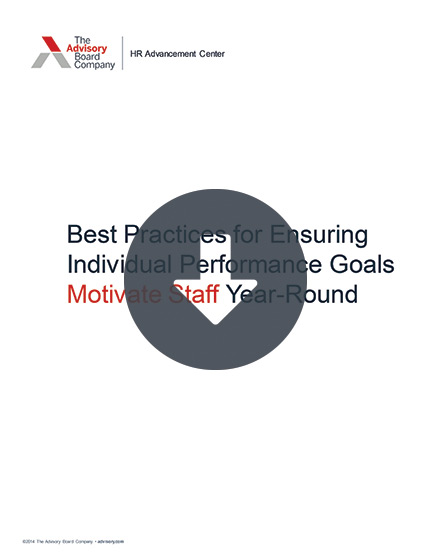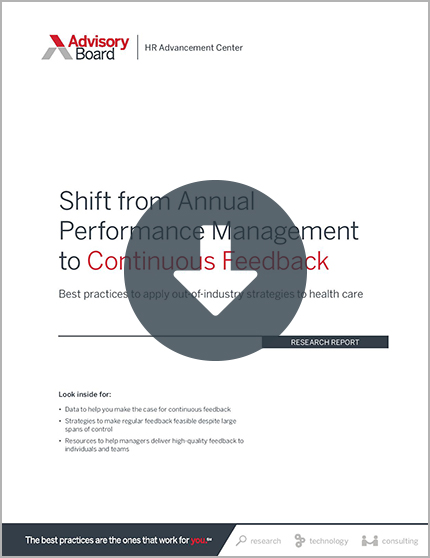Editor's note: This popular story from the Daily Briefing's archives was republished on Jan 11, 2019.
By Jackie Kimmell, Senior Analyst
Part six in a series of the seven conversations all managers should be having with their employees
Just like your New Year's resolutions, your performance goals are likely at the top of your mind when you set them at the beginning of the year. But as spring turns to summer, you and your staff inevitably grow distracted by urgent, day-to-day concerns—until all of a sudden, you look back at the end of the year and realize you didn't quite achieve everything you'd meant to.
So how can you keep your staff, and yourself, focused on your goals from January through December? It starts by setting the right goals, according to Advisory Board's Kate Vonderhaar.
Yes, your goals should be 'SMART.' (But how do you actually make that happen?)
You've probably heard the advice that your performance goals should be "SMART": specific, measureable, achievable, relevant, and time-bound. But just because you know the acronym doesn't mean your team knows how to use it consistently. Vonderhaar spoke with a health system where an HR leader spent hours of her vacation reviewing the 1,500 goals that the system's 500 leaders had submitted. She ended up having to rewrite 40% of them.
So how can you ensure your team actually sets SMART goals? Create a "pick-list" of senior leader and HR-approved goals for staff to choose from, Vonderhaar suggests. These goals should be SMART, should reflect your strategic priorities, and should be tailored to your staff level and team.
To help you get started, Vonderhaar's team has compiled more than 1,000 health care-specific goals, each tailored to four different levels of staff: executives, directors, managers and frontline staff. View the Performance Goal Library to access all of them.
How to keep your team's goals top-of-mind
Once you ensure that your staff have the right goals, how do you make sure that your staff stays on target?
According to Vonderhaar, the key is to find touchpoints that nudge your team to stay conscious of their goals throughout the year.
- Schedule regular, goal-focused check-ins with your direct reports
Vonderhaar strongly advocates for having a goal-focused check-in with all direct reports at least once a year. "Having at least one performance check-in outside of the annual review is so important," she said. "If we want our teams to be constantly improving, they need to know where they stand."
That being said, there's a limit to how much managers can do when they have many direct reports. "In a world of many priorities and limited time," she said, " you might only have a single check-in about goals in the middle of the year. That's OK—although ideally, you're doing more than that."
To make your check-ins as useful as possible, bring data about how your team is doing on their goals and how you believe an individual employee is contributing to the progress. Ask your staffer how they think they are tracking and contributing to the team, and work with them to think about what behavior they could change—or push more on—to meet their goals by the end of the year.
For scripting on the best way to conduct these check-ins, download the Goal-Focused Frontline Check-In Template.
- Create a dashboard that puts key metrics at your team's fingertips
Many strongly goal-oriented organizations use dashboards that list the team's goals and track progress to keep staff focused on what matters, Vonderhaar said.
If you already have a dashboard, try making it more actionable by conducting team huddles at the beginning of every shift to review the team's progress. Bring your dashboard, and ask: "How are we doing? Are we tracking well to meet this goal? If not, what can we change to get on track?"
The great part about this strategy, Vonderhaar said, is that "it helps you touch base with your whole team at once. This shouldn't replace the one-on-one, but in a time-constrained environment, it's an easier way to keep goals top-of-mind for staff."
To learn more about how to use dashboards successfully, explore Practice #5 in the report Shift from Annual Performance Management to Continuous Feedback.
- Reward your team for meeting their goals with targeted incentives
So what should you do when your team actually meets their goals? That's a great moment to provide rewards that have been decided upon by the team in advance, according to Vonderhaar. "Everyone immediately thinks of financial bonuses," she said. "But there are other great ways to incentivize performance that don't require finding a pot of gold."
For instance, the staff in one organization grew motivated to achieve a difficult goal by the "reward" of wearing jeans on Fridays. In another organization, the manager let the nursing staff choose new furniture for their staff lounge when they met certain quality metrics.
If nothing else, "You can't go wrong with food," Vonderhaar said. "Just make sure your team understands the pizza party is in recognition of their strong performance on a goal."
For other suggested reward ideas, as well as scripting to set expectations around them, look at the section on "Recognition" in the Manager's Guide to Engaging Staff.
For further details on how to keep your staff focused on goals throughout the year, and suggestions about the best way to incorporate monetary incentives, download Best Practices for Ensuring Individual Performance Goals Motivate Staff Year-Round.
Don't miss out on the latest Advisory Board insights
Create your free account to access 2 resources each month, including the latest research and webinars.
Want access without creating an account?
You have 2 free members-only resources remaining this month remaining this month.
1 free members-only resources remaining this month
1 free members-only resources remaining this month
You've reached your limit of free monthly insights
Become a member to access all of Advisory Board's resources, events, and experts
Never miss out on the latest innovative health care content tailored to you.
Benefits include:
You've reached your limit of free monthly insights



